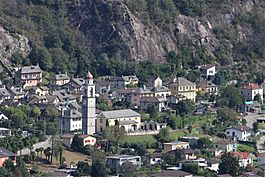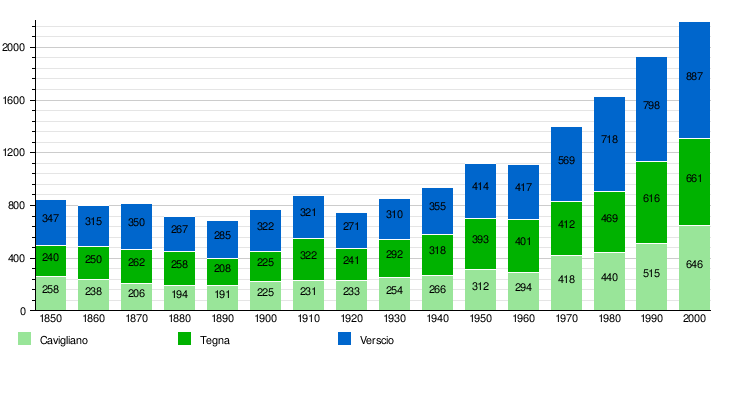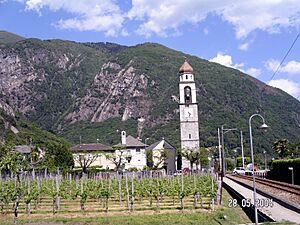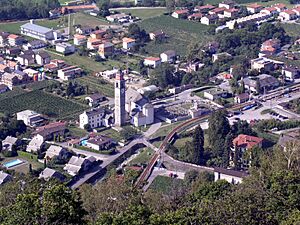Terre di Pedemonte facts for kids
Quick facts for kids
Terre di Pedemonte
|
||
|---|---|---|

Tegna village
|
||
|
||
| Country | Switzerland | |
| Canton | Ticino | |
| District | Locarno | |
| Area | ||
| • Total | 11.59 km2 (4.47 sq mi) | |
| Elevation | 366 m (1,201 ft) | |
| Population
(Dec 2020 )
|
||
| • Total | 2,627 | |
| • Density | 226.66/km2 (587.0/sq mi) | |
| Postal code |
6652, 6653, 654
|
|
| Surrounded by | Intragna, Isorno, Losone, Maggia | |
Terre di Pedemonte is a town in the Locarno area of the Ticino region in Switzerland. It was formed on April 14, 2013, when the towns of Cavigliano, Tegna, and Verscio joined together to create this new municipality.
Contents
A Look Back in Time
Cavigliano's Past
People lived in the Cavigliano area a very long time ago, even during the Bronze Age. We know this because old tools and items from that time have been found. Later, during the Iron Age and the Roman era, more signs of life appeared, like tombs and coins from the 1st to 3rd centuries.
The name Caveliano was first written down in 1213. In the Middle Ages, Cavigliano was part of the larger Locarno and Ascona region. Back then, the villages of Cavigliano, Tegna, Verscio, and Auressio were all part of one community called Pedemonte. Tegna later became its own town in 1464. By 1803, Cavigliano became an independent town, meaning it could make its own rules.
The Church of S. Michele in Cavigliano was built in the 16th century. It became a separate Catholic church parish in 1850.
A train station was built in Cavigliano in 1923, connecting it to Locarno and Domodossola. Since the 1960s, Cavigliano has changed from a farming town to a "commuter town". This means many people who live there travel to work in the bigger city of Locarno. A special center called Casa solidarietà, which helps people and offers education, has been in Cavigliano since 1946.
Tegna's Story
Tegna was first mentioned in records in 1238 as Tenia. Just like Cavigliano, ancient graves from the Bronze Age show that people lived here long ago. There are also remains of an old wall from the La Tène period and a Roman building.
During the Middle Ages, two castles, Tegna Castle and a smaller fortress, were built in the mountains above the village. Today, both are just ruins.
The village church of S. Maria Assunta was first mentioned in the 14th century. At first, it was a smaller church connected to the main church in Verscio. But in 1692/93, S. Maria Assunta became the main church for the Tegna area.
For many years, people in Tegna farmed and raised cattle. Starting in the 16th century, some people would travel seasonally to Livorno for work. In the early 1900s, many residents found jobs building the Locarno-Domodossola railway and power plants. In 1978, a big flood caused a lot of damage to the village.
Verscio's Role
Verscio was first mentioned in 1335 as Varzio. For much of its history, Verscio was the main center for the Pedemonte community, both for its government and its religion.
The village's main church, S. Fedele, was built in 1214. It was the religious center for all the nearby villages until 1692/93 for Tegna and 1850 for Cavigliano. The early church had beautiful old paintings called frescoes. The church tower was built in 1707, and the rest of the church was updated between 1743 and 1748.
In the Middle Ages, people in Verscio farmed the land. From the 16th century, some people would travel to Livorno for seasonal work. Because the soil was not very rich and there wasn't much farmland, the village stayed small and many people were poor. In the 1800s, many residents moved to other countries, and the population of Verscio dropped.
In the 1920s, the watch industry brought about 60 jobs to Verscio. This was important until the 1970s when cheaper watches from other countries hurt the Swiss watch industry. Like Cavigliano, Verscio also became a "commuter town" in the 1960s, with many people traveling to Locarno for work. Today, about three-quarters of the working people in Verscio commute to Locarno.
A special place called Teatro Dimitri was started in Verscio in 1971. It was the first permanent theater in the region. A few years later, it grew into the Scuola Teatro Dimitri (Dimitri Theater School), and by 2004, it became a full high school.
How the Population Changed
This chart shows how the number of people living in Cavigliano, Tegna, and Verscio changed over time:

Important Heritage Sites
The Castelliere, a place with old objects from prehistoric times and Roman buildings, is a very important historical site in Switzerland. Also, the entire village of Verscio is recognized as a special heritage site.






